Dolmabahçe Palace, located on the shores of the Bosphorus in Istanbul, is one of the most stunning architectural landmarks of Turkey. It represents the height of the Ottoman Empire’s artistic and cultural achievements, blending classical European styles with Ottoman traditions. Known for its grandeur, opulence, and intricate details, this palace is not just a royal residence but also a testament to the empire’s political power and artistic mastery. Let’s take a closer look at what makes Dolmabahçe Palace a must-visit historical site. Follow archeology.dulichvn.net to discover many hidden mysteries that have yet to be discovered.
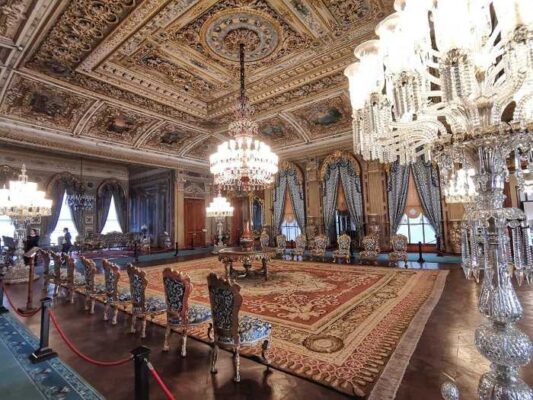
The History Behind Dolmabahçe Palace
A Royal Legacy: The Birth of Dolmabahçe Palace
Dolmabahçe Palace, an iconic symbol of the Ottoman Empire’s evolution, was constructed between 1843 and 1856 under the rule of Sultan Abdülmecid I. The palace marked a significant turning point in Ottoman history, as it replaced the centuries-old Topkapi Palace, which had long been the seat of the Sultan’s court. This transition was more than just a change of location; it represented the empire’s ambition to modernize and align itself with contemporary European trends, signaling the end of the traditional Ottoman era.
The construction of Dolmabahçe was a reflection of Sultan Abdülmecid’s desire to modernize the empire’s administration and architecture, showcasing the power and prestige of the Ottomans as they stepped into a new era.
Construction and Architecture: A Fusion of Western Elegance and Ottoman Tradition
The construction of Dolmabahçe Palace was a grand and ambitious endeavor, requiring the collaboration of both European and Ottoman architects. The palace was built in a neoclassical architectural style, heavily influenced by European baroque, rococo, and empire designs, yet it still maintained elements of traditional Ottoman aesthetics.
The fusion of these diverse influences resulted in a palace unlike any other, where Eastern and Western styles harmoniously coexist. The palace’s exterior features grand columns, ornate facades, and intricate detailing, while the interiors boast lavish rooms adorned with gilded ceilings, crystal chandeliers, and marble floors. The use of luxurious materials, such as Baccarat crystal and gold leaf, highlights the splendor and opulence that marked the reign of Sultan Abdülmecid I. This blend of architectural styles not only reflects the empire’s openness to European culture but also its continued reverence for its Ottoman heritage.
Political and Cultural Importance: A Hub of Power and Diplomacy
Beyond being a royal residence, Dolmabahçe Palace played a pivotal role as the political and administrative center of the Ottoman Empire. It became the seat of government during the later years of the empire, hosting many of the empire’s most important state functions and meetings. The palace served as a backdrop for diplomatic events, where foreign dignitaries were received and high-level political negotiations took place. Its strategic location along the Bosphorus provided an ideal setting for these significant gatherings, symbolizing the empire’s cosmopolitan character.
The architectural grandeur and European-influenced design of Dolmabahçe reflected the Ottomans’ ambition to strengthen their ties with European powers, signaling their desire to modernize and project an image of sophistication and cultural advancement. As the center of both political and cultural life, Dolmabahçe Palace was a symbol of the empire’s evolving identity and a tangible representation of its efforts to bridge East and West.
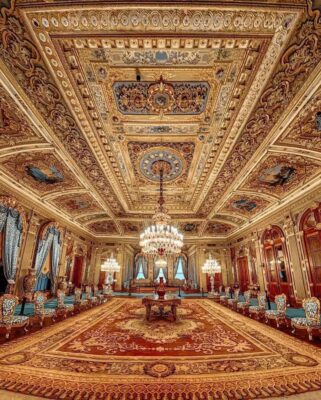
Architectural Wonders of Dolmabahçe Palace
The Grand Entrance: A Majestic Welcome
The grand entrance to Dolmabahçe Palace, known as the “Gate of the Sultan,” is a breathtaking display of Ottoman architectural splendor. As visitors approach, they are greeted by a striking blend of intricate carvings, ornate gold accents, and delicate ironwork that exude royal magnificence. This imposing gateway serves as a dramatic prelude to the palace’s interior, setting the tone for the opulence that lies within. The grandeur of the entrance not only showcases the technical skill of the artisans but also symbolizes the power and prestige of the Sultan’s empire, offering a glimpse into the luxurious world of the Ottoman court.
Lavish Interior Design: A Palace of Elegance and Refinement
Step inside Dolmabahçe Palace, and you are immediately transported into a world of unrivaled luxury. The interior of the palace is nothing short of magnificent, with each room crafted to reflect the finest artistic craftsmanship of the era. The ceilings are adorned with intricate frescoes, depicting scenes of beauty and grandeur, while the walls are covered in gold-leaf detailing that adds an extra layer of splendor.
The elaborate chandeliers hanging from the ceilings are made of crystal, their sparkling brilliance casting a warm glow across the rooms. Every corner of the palace is decorated with intricate designs, from the marble floors to the richly upholstered furniture, creating an atmosphere that speaks of royal opulence. The interior of Dolmabahçe Palace reflects the empire’s wealth and refined taste, making it one of the most lavishly decorated palaces in the world.
The Crystal Staircase: A Symbol of Unmatched Luxury
One of the most iconic features of Dolmabahçe Palace is the Crystal Staircase, a truly extraordinary architectural marvel. This grand staircase, made entirely of crystal and bronze, is not only a physical ascent but also a symbolic journey into the heart of the palace’s opulence.
The staircase, with its gleaming surface and intricate craftsmanship, is said to be the only one of its kind in the world, further enhancing the uniqueness and extravagance of the palace. Its beauty and grandeur are unparalleled, making it one of the standout features of Dolmabahçe. The Crystal Staircase serves as a testament to the unrivaled luxury that defines the entire palace, highlighting the meticulous attention to detail and the immense wealth that once flowed through the halls of the Ottoman court.
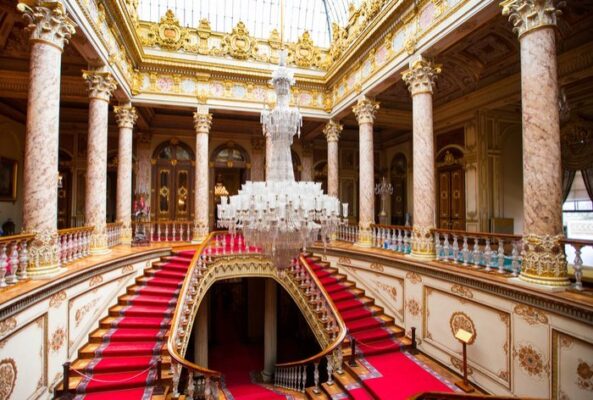
See more: La Ruetta di Civitella: Exploring Italy’s Narrowest Street and Its Role in Medieval Defense
Key Attractions in Dolmabahçe Palace
The Harem: A Glimpse into the Sultan’s Private World
The harem of Dolmabahçe Palace is one of its most intriguing and historically significant sections, offering a rare peek into the intimate world of the Ottoman royal family. As with many other palaces from the Ottoman era, the harem was where the Sultan’s wives, concubines, and children resided, far from the public eye. Unlike the more formal rooms used for state affairs, the harem was a private sanctuary that reflected the personal tastes and lifestyle of the royal household.
Visitors touring the harem will find themselves in rooms meticulously decorated with luxurious furnishings, fine carpets, and delicate mosaics. These spaces, though private, are lavish in their design, with ornate details that reveal the refined tastes of the Sultan and his family. The harem not only gives insight into the domestic life of the Ottoman rulers but also serves as a testament to the cultural richness and complexity of the empire’s courtly traditions.
The Ceremonial Hall: A Monument to Imperial Grandeur
The Ceremonial Hall is the heart of Dolmabahçe Palace, where the most significant state functions, royal receptions, and official ceremonies took place. This grand room, designed to impress, is the epitome of Ottoman imperial splendor. Dominating the space is a magnificent Baccarat crystal chandelier, one of the largest in the world, which casts a brilliant light over the room’s intricate details.
The hall’s high ceilings and expansive dimensions are adorned with exquisite frescoes and gilded accents, emphasizing the magnificence of the Ottoman Empire at its peak. The Ceremonial Hall was not only a venue for political and diplomatic events but also a stage where the empire’s power, wealth, and artistic mastery were proudly displayed. The room exudes an air of elegance and formality, making it one of the most awe-inspiring spaces within the palace.
The Museum: A Journey Through Ottoman History
Dolmabahçe Palace also serves as a museum, offering visitors the opportunity to explore the rich history of the Ottoman Empire through a curated collection of artifacts. The museum showcases a vast array of objects, from royal portraits and intricate furniture to priceless antiques and ornate decorations.
Each exhibit within the palace’s museum tells the story of the empire’s cultural and artistic achievements, providing a deeper understanding of its social, political, and artistic legacy. Visitors can wander through the halls and admire the beautiful royal regalia, fine porcelain, and lavish tapestries, all of which reflect the opulence and refinement of the period. The museum not only serves as a historical archive but also as a testament to the empire’s artistic prowess and its contributions to global culture.
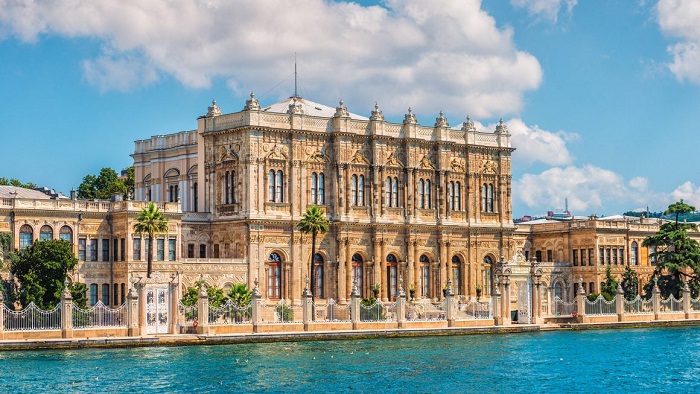
Conclusion: A Jewel of Ottoman Architecture
Dolmabahçe Palace is undoubtedly one of the most spectacular palaces in the world. Its blend of European and Ottoman architectural styles, combined with its lavish interiors and historical significance, makes it a must-visit destination for history enthusiasts and travelers alike. Whether you’re exploring its grand halls, admiring its intricate details, or learning about the Ottoman Empire’s legacy, Dolmabahçe Palace is a true testament to the artistic and political grandeur of its time.

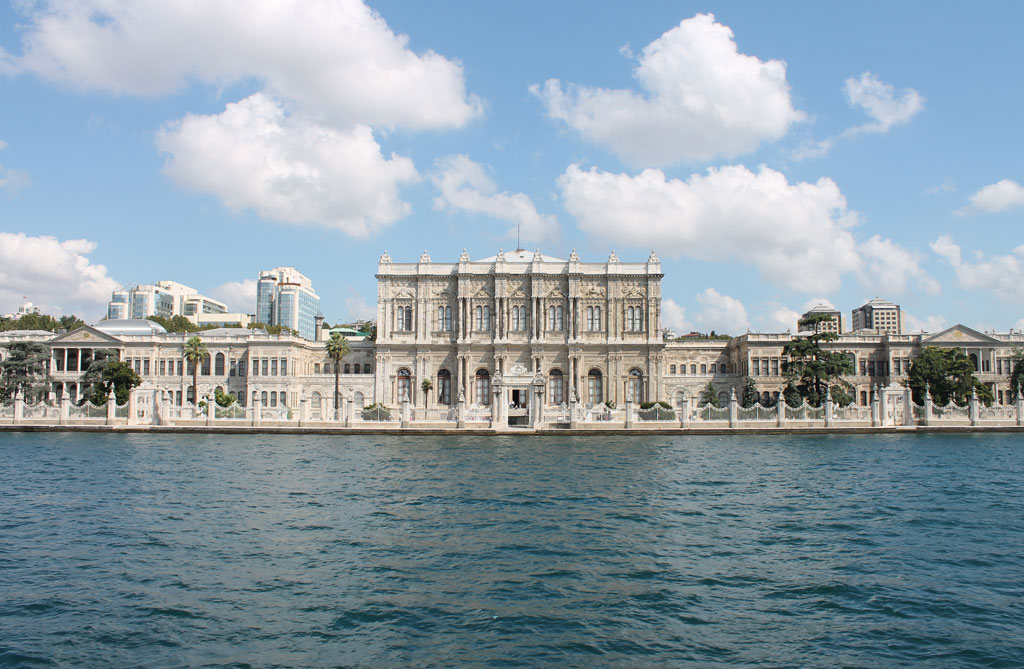
CÁC TIN KHÁC
Mary Walton: The Forgotten Inventor Who Helped Clean Up America’s Cities
Tomb of Queen Nefertari in the Valley of the Queens, Egypt
Discover the Hypostyle Hall of the Temple of Hathor at Dendera
Venus de Losange: Unveiling the Mystery of a 20,000-Year-Old Paleolithic Icon